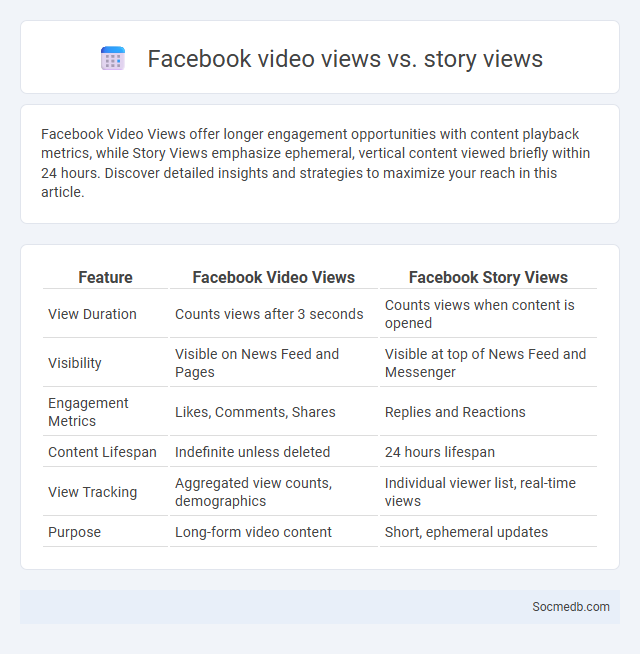
Photo illustration: Facebook Video Views vs Story Views
Facebook Video Views offer longer engagement opportunities with content playback metrics, while Story Views emphasize ephemeral, vertical content viewed briefly within 24 hours. Discover detailed insights and strategies to maximize your reach in this article.
Table of Comparison
| Feature | Facebook Video Views | Facebook Story Views |
|---|---|---|
| View Duration | Counts views after 3 seconds | Counts views when content is opened |
| Visibility | Visible on News Feed and Pages | Visible at top of News Feed and Messenger |
| Engagement Metrics | Likes, Comments, Shares | Replies and Reactions |
| Content Lifespan | Indefinite unless deleted | 24 hours lifespan |
| View Tracking | Aggregated view counts, demographics | Individual viewer list, real-time views |
| Purpose | Long-form video content | Short, ephemeral updates |
Introduction to Facebook Video Views, Story Views, and Video View Metrics
Facebook video views, story views, and video view metrics provide essential insights into content engagement on the platform, helping you measure audience interaction and reach. Video views count the number of times your video plays for at least three seconds, while story views track how many users watch your temporary posts within 24 hours. By analyzing metrics such as average watch time, retention, and unique viewers, you can optimize your content strategy to boost engagement and grow your online presence.
Defining Facebook Video Views
Facebook video views measure the number of times a video is watched on the platform, with key metrics including 3-second views and 10-second views to gauge viewer engagement. The platform distinguishes between autoplay views and intentional clicks, affecting how views are counted for reach and performance analysis. Advertisers and content creators use Facebook Video Views to optimize video campaigns and understand audience retention patterns.
Understanding Facebook Story Views
Facebook Story Views provide valuable insights into the reach and engagement of your content, showing exactly who has watched your stories and for how long. By analyzing viewer demographics and interaction patterns, you can tailor your marketing strategies to enhance audience connection and boost return on investment. Monitoring these insights regularly helps you optimize your social media presence and maximize the impact of your storytelling efforts.
What Is Facebook’s Video View Metric?
Facebook's video view metric measures the number of times a video is watched for at least three seconds, providing insights into audience engagement and content performance. This metric helps you understand which videos capture attention and encourages longer viewing times to improve reach and effectiveness. Tracking video views supports targeted marketing strategies by highlighting popular content and viewer preferences.
Key Differences Between Video Views and Story Views
Video views measure the total number of times your video content has been watched, often including repeat views, while story views track how many unique users have viewed each segment of your ephemeral content. Video views typically have no time limit per view, whereas story views disappear after 24 hours, emphasizing real-time engagement and audience immediacy. Understanding these differences helps you tailor your social media strategy to maximize reach and interaction with Your followers.
How Facebook Measures Video Engagement
Facebook measures video engagement by tracking metrics such as video views, average watch time, and interactions like likes, comments, and shares. Your content's performance is evaluated through audience retention rates and click-through actions from video ads. This data helps optimize video strategies to increase reach and viewer interaction effectively.
Impact on Reach and Audience Growth
Social media platforms significantly enhance your reach by leveraging algorithms that target relevant audiences based on interests and behavior, maximizing visibility. Audience growth accelerates as engaging content encourages shares, comments, and follows, expanding your network organically. Consistent interaction with followers builds trust and loyalty, driving sustained engagement and increased brand awareness.
Best Practices for Maximizing Each Metric
Optimize engagement by tailoring content to your audience's preferences and posting consistently during peak interaction times. Monitor metrics such as reach, impressions, click-through rates, and conversions to identify which types of posts yield the highest performance. Leveraging analytics tools enables you to refine strategies, boost follower growth, and enhance overall social media ROI effectively.
Choosing the Right Format for Your Goals
Selecting the appropriate social media format hinges on understanding the specific goals of your campaign, whether it's brand awareness, engagement, or conversions. Visual content like videos and images typically excel in capturing attention and driving engagement, while text-based posts or infographics are ideal for sharing detailed information and thought leadership. Aligning your content format with your target audience's preferences and platform algorithms ensures maximum reach and impact on your social media strategy.
Conclusion: Optimizing Facebook Content Strategy
Optimizing a Facebook content strategy requires analyzing engagement metrics such as reach, click-through rates, and audience demographics to tailor posts effectively. Leveraging Facebook Insights and A/B testing helps identify high-performing content types, posting times, and formats that resonate with target users. Consistently refining strategy based on data-driven feedback enhances brand visibility, user interaction, and overall ROI on the platform.
 socmedb.com
socmedb.com